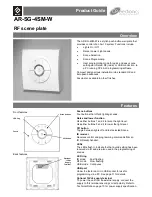
Table 3-7. QNaN and SNaN Handling
With SNaN Operand
With QNaN Operand
Default NaN
Mode
Instruction Type
IOC
a
set. The SNaN is quieted and the
result NaN is determined by the rules
given in the ARM Architecture Reference
Manual.
The QNaN or one of the QNaN operands,
if there is more than one, is returned
according to the rules given in the ARM
Architecture Reference Manual.
Off
Arithmetic CDP
IOC
a
set. Default NaN returns.
Default NaN returns.
On
NaN passes to destination with sign changed as appropriate.
Off/On
Non-arithmetic CDP
IOC set. Unordered compare.
Unordered compare.
-
FCMP(Z)
IOC set. Unordered compare.
IOC set. Unordered compare.
-
FCMPE(Z)
All NaNs transferred.
Off/On
Load/store
a. IOC is the Invalid Operation exception flag, FPSCR[0].
Comparisons
Comparison results modify the flags in the FPSCR. You can use the MVRS APSR_nzcv instruction
(formerly FMSTAT) to transfer the current flags from the FPSCR to the APSR. See the ARM
Architecture Reference Manual for mapping of IEEE 754-2008 standard predicates to ARM conditions.
The flags used are chosen so that subsequent conditional execution of ARM instructions can test
the predicates defined in the IEEE standard.
Underflow
The Cortex-M4F FPU uses the before rounding form of tininess and the inexact result form of loss
of accuracy as described in the IEEE 754-2008 standard to generate Underflow exceptions.
In flush-to-zero mode, results that are tiny before rounding, as described in the IEEE standard, are
flushed to a zero, and the UFC flag, FPSCR[3], is set. See the ARM Architecture Reference Manual
for information on flush-to-zero mode.
When the FPU is not in flush-to-zero mode, operations are performed on subnormal operands. If
the operation does not produce a tiny result, it returns the computed result, and the UFC flag,
FPSCR[3], is not set. The IXC flag, FPSCR[4], is set if the operation is inexact. If the operation
produces a tiny result, the result is a subnormal or zero value, and the UFC flag, FPSCR[3], is set
if the result was also inexact.
3.1.5.6
Exceptions
The FPU sets the cumulative exception status flag in the FPSCR register as required for each
instruction, in accordance with the FPv4 architecture. The FPU does not support user-mode traps.
The exception enable bits in the FPSCR read-as-zero, and writes are ignored. The processor also
has six output pins, FPIXC, FPUFC, FPOFC, FPDZC, FPIDC, and FPIOC, that each reflect the
status of one of the cumulative exception flags. For a description of these outputs, see the
ARM
Cortex-M4 Integration and Implementation Manual
(ARM DII 0239, available from ARM).
The processor can reduce the exception latency by using lazy stacking. See Auxiliary Control
Register, ACTLR on page 4-5. This means that the processor reserves space on the stack for the
FP state, but does not save that state information to the stack. See the ARMv7-M Architecture
Reference Manual (available from ARM) for more information.
3.1.5.7
Enabling the FPU
The FPU is disabled from reset. You must enable it before you can use any floating-point instructions.
The processor must be in privileged mode to read from and write to the
Coprocessor Access
145
June 18, 2014
Texas Instruments-Production Data
Tiva
™
TM4C1294NCPDT Microcontroller
















































